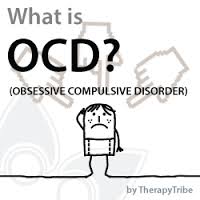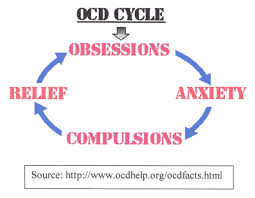- HubPages»
- Health»
- Mental Health»
- Anxiety Disorders
What is Obsessive-Compulsive Disorder?
The clinical picture of Obsessive Compulsive Disorder
We all tend to experience minor obsessive thoughts during our daily lives such as persistent thoughts about a trip or date or a haunting melody we simply cannot seem to get out of our minds. The obsessive personality, however, have thoughts that are much more persistent and irrational which may interfere with everyday behavior.
These neurotic-obsessive thoughts will centre on a wide variety of topics, such as concerns over bodily functions, committing immoral acts, attempting suicide or perhaps finding the solution to some seemingly unsolvable problem. Thoughts of immoral acts are quite common such as murder and assault. For example, a wife may be obsessed with the idea of poisoning her husband or a daughter with the thought of pushing her mother down a flight of stairs. These obsessive thoughts may not be carried out but remain a source or torment to the individual.
There is consistent evidence of minor obsessive thoughts during our daily lives such as stepping over cracks in sidewalks, walking around ladders instead of under them or turning away when a black cat crosses our path. These thoughts do not, however, have that strong element of compulsiveness exhibited by the neurotic individual. Some time or other we will resort to obsessive-compulsive patterns under severe pressure or when trying to achieve goals that we consider to be of critical importance. History has shown that many unique individuals had shown an “obsessive compulsive” adherence to their goals despite discouragement and ridicule. For example, Columbus persisted for 18 years to secure financial aid for his expedition to India and Darwin assembled evidence for 22 years before he could present his ideas on evolution.
Neurotic-compulsive individuals, on the other hand, feel compelled to perform some act which seems strange and absurd to them and which they do not want to perform. These compulsive acts may vary from relatively mild ritual-like behavior, such as making the sign of the cross periodically during the day to more extreme behavior such as washing one’s hands as often as ten times a day. The compulsive act usually brings a feeling of reduced tensions and satisfaction but anxiety could also mount if the person tries to resist the compulsion.
This disorder is considered maladaptive as it represents irrational and exaggerated behavior when stresses occur that are usually not too upsetting to most people and such patterns reduce the flexibility and the capability for self-direction. This behavior takes place in the context of a person who showcases feelings of inadequacy and insecurity, rigid conscience development, a tendency towards guilt and high vulnerability to threat.
What is OCD?

The causes of Obsessive-Compulsive Disorder
Substitutive thoughts and activities
Individuals who suffer from obsessive-compulsive disorder defend themselves from anxiety by persistently thinking of doing something else each time threatening thoughts or impulses arise. “Safe” obsessive thoughts are substitutes for more unpleasant or dangerous ones.
The individual might have a compulsive preoccupation with some unusual activity such as working on a new invention, writing a ground breaking novel or developing a system to beat the horses. This insurmountable task may never be completed but by working on it the individual is kept so busy that there is no time to deal with unpleasant problems. The compulsive behavior may also be directed toward a constructive task. It does become neurotically compulsive if it is used as an escape from marital, sexual, interpersonal or other problems and generally interferes with effective living.
Substitutive thoughts may be more complicated and could involve the defense mechanism of reaction formation. The individual may then think or act in ways directly contrary to the dangerous thoughts or impulses.
In certain stressful instances obsessive fantasies may also help repressed desires and provide a substitute for overt action. However, not all individuals with obsessive thoughts of violence towards others escape guilt feelings.
Guilt and fear of punishment
This condition could also evolve from feelings of guilt and self-condemnation. For example, Lady Macbeth’s symbolic hand washing after her participation in the murder of King Duncan reveals her ritualistic behavior aimed at the cleansing of guilt for immoral behavior.
Assurance of order and predictability
A rigid ordering of behavior can be temporarily adaptive during a difficult period. The neurotic-compulsive individual confronted by danger may soon attempt to maintain some semblance of order and control by becoming unduly meticulous and methodical. This rigidity helps to prevent anything from going wrong and provides some security and predictability. However, if anything fails during this strict regime the entire defensive structure is endangered and the individual feels threatened and anxieties.
Apparently this pattern is similar to the repetitive and rigid rituals used by underdeveloped civilizations as a means of warding off evil forces in an unpredictable world. These rituals had to be faithfully observed and performed in rigidly prescribed ways in order to be effective.
Three basic aspects of therapy
Therapy usually follows three basic strategies: helping the individual to discriminate between thought and action, to accept “forbidden” desires and to integrate them into a self-structure; helping the individual to discriminate between objective and imagined dangers and to respond selectively to each and blocking obsessive-compulsive rituals by rewarding departures from such neurotic behavior.
These strategies are aimed at eliminating neurotic defenses and helping the individual realize that lives are by no means over after their removal. However, the basic obsessive compulsive lifestyle may not be changed although therapy does lead to an alleviation of symptoms and ensures the way for long term improvement.
The OCD Cycle










